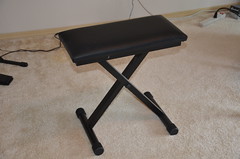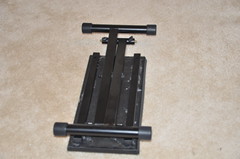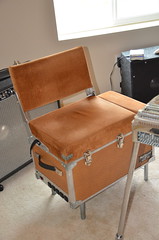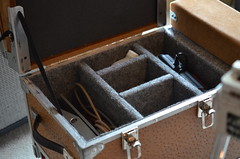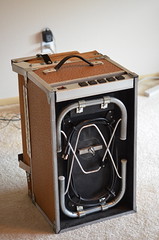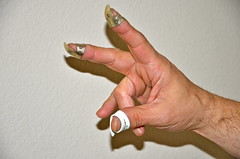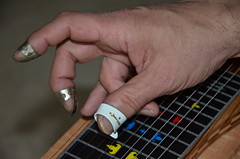Send me feedback, suggestions, questions or corrections to what I present.
This blog is about my love and passion for the pedal steel guitar. I will post discussions about the pedal steel guitar, copedants, learning styles, and my journey learning this instrument.
Tuesday, April 30, 2013
Music Theory Part II -- Minor Scales
Send me feedback, suggestions, questions or corrections to what I present.
Monday, April 29, 2013
E9/C6 Tuning Copedants (Pedal/Knee Lever) Arrangement
I have been seeing requests for the tuning and copedant arrangement for both the E9 neck and the C6 neck. While I described these in Description of a steel guitar, I thought I would break them out separately.
For those of you interested in the Universal tuning E9/B6 I will refer you to the Pedal Steel Pages
For those of you interested in the Universal tuning E9/B6 I will refer you to the Pedal Steel Pages
E9
String Pitch A B C LKL LKV LKR RKL RKR
1 F# G#
2 D# E D
3 G# A
4 E F# F D#
5 B C# C# A#
6 G# A F#
7 F#
8 E F D#
9 D C#
10 B C# A#
C6
String Pitch P4 P5 P6 P7 P8 LKL LKR RKL RKR
1 G G#
2 E F
3 C D B C#
4 A B B G# A#
5 G F#
6 E D#
7 C C#
8 A B
9 F F# E
10 C D A
Sunday, April 28, 2013
Music Theory Part I -- The Major Scales
This is my first of several posts on music theory. I start with major scales and a detailed explanation of how to find and build each major scale.
As always send me feedback on this or any post.
As always send me feedback on this or any post.
Saturday, April 13, 2013
Steel Guitar Seats
One of the accessories your going to need to get at some point is a steel guitar seat. They come in many sizes, options and with many color and fabric selection to suit your taste. They can be pricey at $250 or so depending on what you want.
My first seat when I was a kid playing the lap steel was the kitchen table chair. Not the best but it worked and as a kid I did not know any better. When I bought my first steel guitar I opted for a cheap solution until I could figure out what I wanted. I bought a folding bench for about $80.
It had various height adjustments and it folded down for easy storage. It is a workable solution. One day, one of the pins holding the bench in place broke and forced me to look for a seat. I remembered Joe Naylor from Steel Guitar Seat having met him at the Dallas show. I looked him up online and I selected a monster of a seat side car, seat back and power strip. That added weight is not much but with a 78 pound guitar and a 60 pound amp the 40 pounds of a seat is a bit much. Love the seat and keep it in my studio. I ordered a second seat from Joe that is just a basic seat for lugging around. I have not received it yet and am looking forward to its arrival.
You can get what you need that will suit your purposes. Now Joe is not the only supplier of steal seats but I like Joe, he is personable and will bend over backwards to help you.
The link to Joe's site is steelseat.com
My first seat when I was a kid playing the lap steel was the kitchen table chair. Not the best but it worked and as a kid I did not know any better. When I bought my first steel guitar I opted for a cheap solution until I could figure out what I wanted. I bought a folding bench for about $80.
It had various height adjustments and it folded down for easy storage. It is a workable solution. One day, one of the pins holding the bench in place broke and forced me to look for a seat. I remembered Joe Naylor from Steel Guitar Seat having met him at the Dallas show. I looked him up online and I selected a monster of a seat side car, seat back and power strip. That added weight is not much but with a 78 pound guitar and a 60 pound amp the 40 pounds of a seat is a bit much. Love the seat and keep it in my studio. I ordered a second seat from Joe that is just a basic seat for lugging around. I have not received it yet and am looking forward to its arrival.
You can get what you need that will suit your purposes. Now Joe is not the only supplier of steal seats but I like Joe, he is personable and will bend over backwards to help you.
The link to Joe's site is steelseat.com
C6 Kansas City Continued
Now this is the last post I was working on before I went missing for a month. I debated on whether I would delete it or not and decided not to delete rather post it. It shows some of the lapses in memory as when I came back to the guitar what I was working on. I guess I should read my own posts/journals so I pick up where I left off. Lesson learned.
Ok, I went to my lesson last night and my instructor and I had a conversation about forgetting songs. He told me that playing on the E9 neck will get boring after a while to which I cannot agree or disagree since it is the only neck I have played on till I started on Kansas City on the C6 neck. I can say that what I have learned and what I hear on the C6 neck is awesome. The next point my instructor made with me is that forgetting songs is not a bad thing as we will come back to them later and re-learn the songs I forget. Now, this I have experienced first hand as I have posted on this before. I have noticed when I forget a song and come back to it later and re-learn it, I play the song much better than I did before. I think it is even possible that forgetting the song and coming back to it later has made a more significant improvement than if I had not forgot the song. Perhaps it is the fact that even if I forget songs it is my technique that is improving. So, I am yielding to this concept and not worrying about remembering songs -- for now.
Now as far as this lesson is concerned, I learned more of Kansas City and also focused on what else? Exactly, palm harmonics. We moved around the fret board using palm harmonics slides and volume swells. We also worked on some reverse rolls as well. Forward rolls I have down, however, reverse rolls are not as good as I want and I have to admit I do not practice reverse rolls as much. That will need to change and I need to start including them in my practice routine.
Ok, I went to my lesson last night and my instructor and I had a conversation about forgetting songs. He told me that playing on the E9 neck will get boring after a while to which I cannot agree or disagree since it is the only neck I have played on till I started on Kansas City on the C6 neck. I can say that what I have learned and what I hear on the C6 neck is awesome. The next point my instructor made with me is that forgetting songs is not a bad thing as we will come back to them later and re-learn the songs I forget. Now, this I have experienced first hand as I have posted on this before. I have noticed when I forget a song and come back to it later and re-learn it, I play the song much better than I did before. I think it is even possible that forgetting the song and coming back to it later has made a more significant improvement than if I had not forgot the song. Perhaps it is the fact that even if I forget songs it is my technique that is improving. So, I am yielding to this concept and not worrying about remembering songs -- for now.
Now as far as this lesson is concerned, I learned more of Kansas City and also focused on what else? Exactly, palm harmonics. We moved around the fret board using palm harmonics slides and volume swells. We also worked on some reverse rolls as well. Forward rolls I have down, however, reverse rolls are not as good as I want and I have to admit I do not practice reverse rolls as much. That will need to change and I need to start including them in my practice routine.
Friday, April 12, 2013
Tabledit
Ok, ok, I know I promised more on Tabledit and I have finally some of my experiences to share.
I am one of those men that never asks for directions when lost nor do I read instruction manuals until I get frustrated. So is the way with Tabledit. I finally got frustrated enough I started looking at the manual and was able to find what I was looking for. Surprise! Right?
When you first launch Tabledit, it is in guitar mode so you have to change it for Pedal Steel Guitar. This is accomplished by going to The menus across the top and choose Score and then Instrument.
I am one of those men that never asks for directions when lost nor do I read instruction manuals until I get frustrated. So is the way with Tabledit. I finally got frustrated enough I started looking at the manual and was able to find what I was looking for. Surprise! Right?
When you first launch Tabledit, it is in guitar mode so you have to change it for Pedal Steel Guitar. This is accomplished by going to The menus across the top and choose Score and then Instrument.
This will take you to the Instrument Dialog Box shown below. It will default to the Module tab.
Next, you will select the Tuning Tab and you will see the dialog box below. In the center you see PSG E9 Chromatic (which I already changed) with the up/down selection arrows.
Select the arrows and you can see all the instruments supported by Tabledit. For our purposes we are interested in the PSG E9 Chromatic and PSG C6. Select the PSG E9 chromatic and select ok.
Now you can look at the main window on the left side you will see all 10 strings with the pitch for each string listed. Pretty cool.
Now when I enter the first few notes of Steel Guitar Rag with hammer on and slides, tabledit inserts the notes in the Treble Clef for me! The result is below albeit not exactly correct yet, but you get the idea.
Another thing I found you can do with tabledit that I have not played with yet is that you can import a MIDI file of a song and tabledit will transpose it into tablature. I will be using my Presonus Mixer/recorder to try this out in the coming weeks.
As always let me know what you think. any comments or suggestions are always welcome.
Tuesday, April 9, 2013
Thoughts On Learning The Steel Guitar Part II
In this post I would like to discuss both student responsibilities as well as Instructor responsibilities. Of course, as always this my opinion and solely based on my short time learning the steel since 2009.
Student Responsibility
Most of us learning or wanting to learn the steel guitar either work full time or are students. Unless you are independently wealthy, you need to be able to afford the initial investment required.
As it has been said many times before, regardless of what you learn or study you must set aside time dedicated to your effort. When I was a youngster learning the lap steel, our instructor wanted us to practice 30 minutes a day. His belief was that there was a diminished return on practicing longer. For beginning students especially younger students this is true as they become more easily discouraged because they do not see the immediate benefit of longer practice sessions. Also younger students learn more quickly than their adult counterparts. However, adult students do understand the benefit of longer practice sessions. As adults we have learned about delayed gratification, improved skill by repetition, and patience through life's lessons. Understand your daily life responsibilities, your drive and passion and schedule practice time daily. I would recommend at least one hour a day. Sometimes when I get home after work, I just do not want to practice. Yet I drag my sorry self to my guitar and practice. What I find is that I get in the groove and practicing energizes me. Also the opposite can be true, especially when I have been practicing long sessions over a long period of time. In this case, I either cannot get in the groove or I just cannot get it right. Time for a break! My point is there is nothing wrong with taking a break; just make sure your motivation for not practicing is not laziness.
During your practice sessions start out with picking exercises. An example would be 6th string with thumb, 5th string with 1st finger and 4th string with middle finger blocking each string after picking. Do not worry about speed, rather concern yourself with accuracy an precision. In time speed will come with the accuracy needed. Do this for 5 or 10 minutes and move on to another technique like rolls or harmonics. If you are learning a song then practice the song you are learning. If you get bored or need a break go back to techniques. Always relax and this sounds easier than done. Remember to breathe and don't hold your breath. When I was learning a somewhat difficult picking pattern (for a beginner), my instructor was watching my attempts at mastering the technique. After several attempts he stopped me and told me to take a break. During our break we had the discussion about relaxing and breathing. When the break was over and I attempted the technique I started getting the technique.
Record your practice sessions. When you get discouraged with your progress go back and listen to your recordings when you first started learning. You will be amazed at your progress. This a great confidence builder. Let me share a personal experience with you. The first song I learned was steel Guitar Rag. After I had learned the song, I recorded myself on my cassette recorder. Moving forward over a year, I was organizing my tapes and came upon this recording which I had forgotten about. I chuckled to myself and thought I would play the recording. When I hit the play button I was horrified at what I heard. It was not a song I was hearing! It was a stream of notes being fired off like a machine gun. There was no timing, no rhythm. It was awful. I then realized how far I had come and how far I had to go. I went back to my instructor and explained my discovery and apologized to him for the offense to his ears. My instructor patiently worked with me to get the timing and phrasing of the song down. This single incident changed the approach to learning for me.
When you are not at your guitar you can still practice. First, listen to steel guitar music. In the beginning you will think "I wish I could be good enough to play like that." After a while, you will recognize patterns and techniques and you will say to yourself "I think I can learn to play like that." Then after much practice and learning you will be playing what you thought to be impossible! Some of my favorite artists include Jerry Byrd, Jimmy Day, Lloyd Greem, and Speedy West all of which I have their albums on my iPod. Other albums I listen to include a CMH album Totally Hot Nashville which includes some TV theme songs, La Bamba and others. Another CMH album I like is A Tribute To The Eagles.
Also search Youtube and other sources on the internet for songs, techniques and such that interest you. Bring them to your instructor and he/she may be able to work them in your lessons in a way that benefits you for your skill at the time.
One of the other things I did was to practice forward and backward rolls on a table top. This drove my girlfriend nuts when we are at a restaurant and I am thumping on the table.
In short:
Practice daily
Set a schedule
Practice techniques daily
Record yourself
Breathe
Relax
Listen to Steel Guitar music
Be critical of yourself but do not be harsh. We are our own worst critic.
As always I am open to feed back and your own experiences and advice learning the steel guitar.
Student Responsibility
Most of us learning or wanting to learn the steel guitar either work full time or are students. Unless you are independently wealthy, you need to be able to afford the initial investment required.
As it has been said many times before, regardless of what you learn or study you must set aside time dedicated to your effort. When I was a youngster learning the lap steel, our instructor wanted us to practice 30 minutes a day. His belief was that there was a diminished return on practicing longer. For beginning students especially younger students this is true as they become more easily discouraged because they do not see the immediate benefit of longer practice sessions. Also younger students learn more quickly than their adult counterparts. However, adult students do understand the benefit of longer practice sessions. As adults we have learned about delayed gratification, improved skill by repetition, and patience through life's lessons. Understand your daily life responsibilities, your drive and passion and schedule practice time daily. I would recommend at least one hour a day. Sometimes when I get home after work, I just do not want to practice. Yet I drag my sorry self to my guitar and practice. What I find is that I get in the groove and practicing energizes me. Also the opposite can be true, especially when I have been practicing long sessions over a long period of time. In this case, I either cannot get in the groove or I just cannot get it right. Time for a break! My point is there is nothing wrong with taking a break; just make sure your motivation for not practicing is not laziness.
During your practice sessions start out with picking exercises. An example would be 6th string with thumb, 5th string with 1st finger and 4th string with middle finger blocking each string after picking. Do not worry about speed, rather concern yourself with accuracy an precision. In time speed will come with the accuracy needed. Do this for 5 or 10 minutes and move on to another technique like rolls or harmonics. If you are learning a song then practice the song you are learning. If you get bored or need a break go back to techniques. Always relax and this sounds easier than done. Remember to breathe and don't hold your breath. When I was learning a somewhat difficult picking pattern (for a beginner), my instructor was watching my attempts at mastering the technique. After several attempts he stopped me and told me to take a break. During our break we had the discussion about relaxing and breathing. When the break was over and I attempted the technique I started getting the technique.
Record your practice sessions. When you get discouraged with your progress go back and listen to your recordings when you first started learning. You will be amazed at your progress. This a great confidence builder. Let me share a personal experience with you. The first song I learned was steel Guitar Rag. After I had learned the song, I recorded myself on my cassette recorder. Moving forward over a year, I was organizing my tapes and came upon this recording which I had forgotten about. I chuckled to myself and thought I would play the recording. When I hit the play button I was horrified at what I heard. It was not a song I was hearing! It was a stream of notes being fired off like a machine gun. There was no timing, no rhythm. It was awful. I then realized how far I had come and how far I had to go. I went back to my instructor and explained my discovery and apologized to him for the offense to his ears. My instructor patiently worked with me to get the timing and phrasing of the song down. This single incident changed the approach to learning for me.
When you are not at your guitar you can still practice. First, listen to steel guitar music. In the beginning you will think "I wish I could be good enough to play like that." After a while, you will recognize patterns and techniques and you will say to yourself "I think I can learn to play like that." Then after much practice and learning you will be playing what you thought to be impossible! Some of my favorite artists include Jerry Byrd, Jimmy Day, Lloyd Greem, and Speedy West all of which I have their albums on my iPod. Other albums I listen to include a CMH album Totally Hot Nashville which includes some TV theme songs, La Bamba and others. Another CMH album I like is A Tribute To The Eagles.
Also search Youtube and other sources on the internet for songs, techniques and such that interest you. Bring them to your instructor and he/she may be able to work them in your lessons in a way that benefits you for your skill at the time.
One of the other things I did was to practice forward and backward rolls on a table top. This drove my girlfriend nuts when we are at a restaurant and I am thumping on the table.
In short:
Practice daily
Set a schedule
Practice techniques daily
Record yourself
Breathe
Relax
Listen to Steel Guitar music
Be critical of yourself but do not be harsh. We are our own worst critic.
As always I am open to feed back and your own experiences and advice learning the steel guitar.
Sunday, April 7, 2013
Right Hand Techniques
In this post I wanted to cover some of the basic right hand technique. This post is directed at the beginner. Once I get my video set up I will add some video clips of these where appropriate.
Attack
One of the tendencies when you first start playing is to attack the strings to hard. I guess for me it was a way I tried to compensate for not getting sustain. In fact, attacking the strings too hard does the opposite and does not give you the tone you are looking for. Be kind to your strings and less attack. Let the natural tone of the guitar work for you.
One of the first techniques I learned was palm blocking. Were going to use strings 4-5-6 on the E9 neck. keep your right edge of your picking hand on the pickups. Place your thumb pick against the 6th string, first finger pick against the 5th string and your middle finger against the 4th string. Now pick the 6th string and then block the string using the right edge of your picking hand and block the string. Pick the 5th string and block. Pick the 4th string and block. Do this slowly as this is not a race but you are training the muscle memory of your fingers. Speed will come in time. Spend about 5 to 10 minutes a day practicing this. Any more and you will die from boredom.
The major triads are picking groups of strings together. The major triads are 3rd, 4th, and 5th strings usually represented as 3-4-5. There are also 4-5-6, 5-6-8, 6-8-10. These will not be the only groups you will use, however, they are the most frequent. I would suggest practicing each of these groups and work your way up playing 6-8-10, 5-6-8, 4-5-6, and 3-4-5. Then repeat the other direction. Soon your fingers will find the groups automatically. Once you get this down try rolling the groups especially 5-6-8 and 6-8-10.
This is not the time to worry about speed picking. As you do the exercises above you will find it difficult enough to do slowly. What you want is consistent precision. To get this it requires building muscle memory. This happens over time and as you practice over and over and over, you will develop speed.
Attack
One of the tendencies when you first start playing is to attack the strings to hard. I guess for me it was a way I tried to compensate for not getting sustain. In fact, attacking the strings too hard does the opposite and does not give you the tone you are looking for. Be kind to your strings and less attack. Let the natural tone of the guitar work for you.
Palm Blocking
One of the first techniques I learned was palm blocking. Were going to use strings 4-5-6 on the E9 neck. keep your right edge of your picking hand on the pickups. Place your thumb pick against the 6th string, first finger pick against the 5th string and your middle finger against the 4th string. Now pick the 6th string and then block the string using the right edge of your picking hand and block the string. Pick the 5th string and block. Pick the 4th string and block. Do this slowly as this is not a race but you are training the muscle memory of your fingers. Speed will come in time. Spend about 5 to 10 minutes a day practicing this. Any more and you will die from boredom.
Finger Blocking
Finger blocking is when you pick a string and then place your picking finger against the string to block the tone. It has a different sound than palm blocking. Move back and forth between palm blocking and finger blocking.Hammer On/Off
Hammer On and Hammer Off are easy techniques to learn. With your first finger pick the open 4th string. As the string rings out place the tone bar on the 2nd fret. Hammer off is the opposite maneuver. With the bar on the 2nd fret, pick the 4th string and as the string rings remove the bar from the 2nd fret. You have just learned what you need for Steel Guitar Rag!Roll
A roll sounds like a strum. Using strings 4-5-6 where thumb on 6th string, first finger on 5th string, and middle finger on the 4th string. Now pick 6, 5, and 4 in that order letting each string ring out. It should sound like a strum with even intervals between the picking of each string.Raking
There is both forward raking and backward raking. Forward raking is strumming the strings from 10th string to the first string. Now you do not need to start with the 10th string. You could start from any string and stop at any string. I have raked from the 8th string to the 2nd string. In this instance I add the safety of putting my ring finger against the 1st string to prevent me from accidentally striking the first string. The reverse rake is exactly the opposite of the forward rake. While I have not used the reverse rake, I have seen my instructor use it.Finger Harmonics
Some people find harmonics easy and others find it difficult. I have a more difficult time with palm harmonics than I do with finger harmonics. This is a re-post from My Journey Part I.
1. Place your tone bar on a fret. For our purposes lets use the 3rd fret.
2. Now you get to hold your picking hand in a weird contorted position. With your picking hand in front of you, hold your thumb in the 9 o'clock position with your forearm at a 30 degree (approximately) to your body. Your ring finger will be at the 9 o'clock position. Your middle finger will be pointing straight back at your body. The proper position will have the middle finger parallel the fret markers.
3. With tone bar at the 3rd fret, we need to pick one octave up at the 15th fret. Pick the 4th string with thumb and middle finger at the same time. The image below shows me at the 17th fret.
Do not be surprised if you get a "thunk" sound the first few times you do this. What you will need to do is ensure your tone bar is properly placed. Just because you are exactly on the 3rd fret does not ensure a harmonic. If you are tuned slightly flat or sharp you will need to adjust your placement of the tone bar. Also, in conjunction with tone bar placement, you may pick slightly flat or sharp around the 15th fret to find the "sweet spot" of your guitar. Some guitars are more forgiving than others.
Tip:
After you get the basic technique down for harmonics, here is an exercise that helped me. Place your tone bar at the 5th fret. Pick your harmonics at the 15th fret, picking all ten strings. I start at the 10th string and work my way up to the 1st string and then back down. Now, leaving your tone bar at the 5th fret, move down to the 12th fret and pick the harmonic there repeating the 10 string process. Do you notice it is a little harder to hit the harmonic? Once you get this down, repeat the process leaving the tone bar at the 5th fret and move your picking hand to the 10th fret and pick all ten strings up and down. Finally, leaving the tone bar at the 5th fret, move your picking hand to the 8th fret and pick the harmonic on all 10 strings up and back down. I promise you that there is a harmonic at each of these positions. What this exercise will do for you is improve your precision. It is very difficult to get the harmonic at the 8th fret. Once you get it down, then your harmonic at the 15th fret will be almost effortless. This is what I mean by paying attention to details. This will take hours upon hours of practice. I do not know why, I picked this harmonics up pretty quickly. Maybe you will and maybe you will struggle with it. If you do this exercise, I would like to hear from you on your success or frustration with it.
Once I had the harmonics down, I learned the entire song sleepwalk using the harmonic pick and slide. Maintaining sustain during a slide with a harmonic is difficult in my opinion. At first it was dying before I could complete my slide. Again, I practiced this one move hour upon hour until I started getting it. To this day two years later, I still practice harmonics daily.
Palm Harmonics
With Palm Harmonics you are doing the same thing with the right edge of your picking hand that the finger does for you in finger harmonics. In my opinion it is more difficult to find the "sweet spot" with palm harmonics because it is harder to judge where your palm is on the fret board than it is with finger harmonics. I still practice it and I will get better. By the way, I use this method when I am raking strings. If I am picking one or two strings I use finger harmonics.Major Triads
The major triads are picking groups of strings together. The major triads are 3rd, 4th, and 5th strings usually represented as 3-4-5. There are also 4-5-6, 5-6-8, 6-8-10. These will not be the only groups you will use, however, they are the most frequent. I would suggest practicing each of these groups and work your way up playing 6-8-10, 5-6-8, 4-5-6, and 3-4-5. Then repeat the other direction. Soon your fingers will find the groups automatically. Once you get this down try rolling the groups especially 5-6-8 and 6-8-10.
Speed Picking
This is not the time to worry about speed picking. As you do the exercises above you will find it difficult enough to do slowly. What you want is consistent precision. To get this it requires building muscle memory. This happens over time and as you practice over and over and over, you will develop speed.
Saturday, April 6, 2013
Selecting Bars and Picks
In this post I want to talk about bars and picks. Lets start with bars. I use bar, slide and tone bar interchangeably. The bar needs to be long enough to accommodate your 6,8, 10, or 12 string guitar. The next thing to consider is the material of the bar. There are bars with composite coatings and others from stainless steel. I have used both and I prefer the stainless steel variety. The next thing to consider is the diameter of the bar. Bars come in 7/8", 15/16", and 1" diameters. The larger diameter bars will sustain better and the heavier the bar helps sustain. The smaller diameter bars are easier to be precise with. I have been using a 7/8" bar and I am going to switch to a 15/16" bar.
Picks
I use National thumb picks as they are more comfortable on my thumb than others. Look around and pick what feels like a good fit for you. I paid particular attention to the blade of the pick. Some were too wide or had unusual shapes for which I could not appreciate how I felt I had to position my right hand. Other people may have more specific reasons for picking one thumb pick over another and I would love to hear those opinions and share them. Who knows I may change my opinion.
With the finger picks there are two things to consider. First, the thickness of the material. I use a Dunlop 0.13 thick pick. It is made out of nickel and silver. Another good brand to consider is National. My very first set of finger picks were National. My reason for switching to Dunlop was laziness! The Dunlop was readily available locally. Since my initial switch, my local supplier has not kept their supplies levels upo. I may end up switching back to Nationals if I have to order them.
Wearing and molding the finger picks is something I need to share with you. You have to be careful how you mold the finger picks. When I put new picks on for the first time I slide the pic up my finger at about the mid point on the band is lined up with the bottom of the cuticle. carefully bend the pick around your finger with the pick on. Now, for the tricky part. You need a flat surface like a desk or table and NOT the top of your guitar. place your finger on the table with the base of the pick resting on the table. Now slowly roll your finger until your finger tip is vertical. This will roll the pick smoothly to your finger. You do not want any harsh bends. When you play the guitar if the band gets stuck on a string above where you want to play, you need to adjust/mold the pick closer to your finger. Also make sure that your hand is in the proper picking position.
After the last roll in the picture above you may still need to bend the pick. Place a finger along the underside of the pic and gently roll the pick toward the tip of your pick finger. When done make sure the side rings are flat against the top of your finger otherwise they will catch on strings when you play.
If you get a crease in the pick then you did not do it right.
With the pictures and the description, I hope this is clear. It is better to show someone in person. If you have difficulty or need more information send mea message.
 |
| Stainless Steel Bar 15/16" and Tribo Tone bar 7/8" |
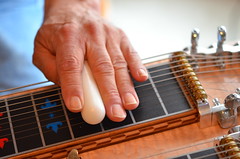 |
| 7/8" on Fret board - Note the amount of area compared to the 15/16" bar |
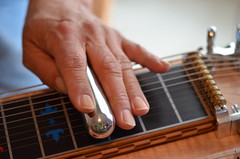 |
| 15/16" Stainless Steel slide |
Picks
I use National thumb picks as they are more comfortable on my thumb than others. Look around and pick what feels like a good fit for you. I paid particular attention to the blade of the pick. Some were too wide or had unusual shapes for which I could not appreciate how I felt I had to position my right hand. Other people may have more specific reasons for picking one thumb pick over another and I would love to hear those opinions and share them. Who knows I may change my opinion.
With the finger picks there are two things to consider. First, the thickness of the material. I use a Dunlop 0.13 thick pick. It is made out of nickel and silver. Another good brand to consider is National. My very first set of finger picks were National. My reason for switching to Dunlop was laziness! The Dunlop was readily available locally. Since my initial switch, my local supplier has not kept their supplies levels upo. I may end up switching back to Nationals if I have to order them.
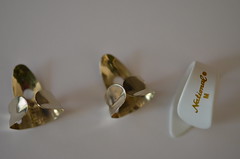 |
| Steel guitar Picks |
Wearing and molding the finger picks is something I need to share with you. You have to be careful how you mold the finger picks. When I put new picks on for the first time I slide the pic up my finger at about the mid point on the band is lined up with the bottom of the cuticle. carefully bend the pick around your finger with the pick on. Now, for the tricky part. You need a flat surface like a desk or table and NOT the top of your guitar. place your finger on the table with the base of the pick resting on the table. Now slowly roll your finger until your finger tip is vertical. This will roll the pick smoothly to your finger. You do not want any harsh bends. When you play the guitar if the band gets stuck on a string above where you want to play, you need to adjust/mold the pick closer to your finger. Also make sure that your hand is in the proper picking position.
 |
| Initial position on the finger |
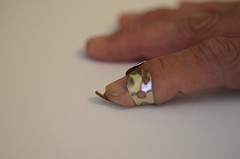 |
| Ready to mold the pick |
 |
| Start rolling your finger |
 |
| Continue rolling your finger |
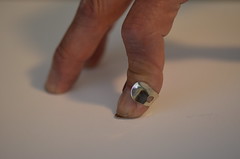 |
| Almost done! |
After the last roll in the picture above you may still need to bend the pick. Place a finger along the underside of the pic and gently roll the pick toward the tip of your pick finger. When done make sure the side rings are flat against the top of your finger otherwise they will catch on strings when you play.
If you get a crease in the pick then you did not do it right.
With the pictures and the description, I hope this is clear. It is better to show someone in person. If you have difficulty or need more information send mea message.
Tuesday, April 2, 2013
My Journey Countinuing April 2013
Now that I am taking lessons 6 days a week my schedule is full! I have finished learning Walking After Midnight and have returned to Kansas City believing I had forgotten the song. To my surprise, while I had forgotten the song, when y instructor gave me the first couple of chords I remembered a few bars which in turn jarred my memory for a few more bars. I then took a break and went back and played Walking After Midnight from start to finish. I then went back to Kansas City and played what I remembered of the song. In my opinion my taking lessons 6 days a week is helping greatly. My instructor is taking the approach of teaching me songs that teach me the techniques I need for the C6 neck. Also, he is taking one lesson per week to focus strictly on technique. For now he is having me focus on precision. I am learning how to move between first and second octave quickly and be spot on the fret. At the same time I am trying to burn the pitch into my brain so I can know I am on fret by ear.
One of the problems I reported in an earlier post was my picking hand drifting south while playing. I am happy to report that I have corrected that problem! Now my right hand position is automatic and stays put even when my stress level goes up.
I am working on apostrophe about tone bars and my opinion on selecting a tone bar. I will also include a discussion on selecting picks and how to wear them.
One of the problems I reported in an earlier post was my picking hand drifting south while playing. I am happy to report that I have corrected that problem! Now my right hand position is automatic and stays put even when my stress level goes up.
I am working on apostrophe about tone bars and my opinion on selecting a tone bar. I will also include a discussion on selecting picks and how to wear them.
Subscribe to:
Posts (Atom)
